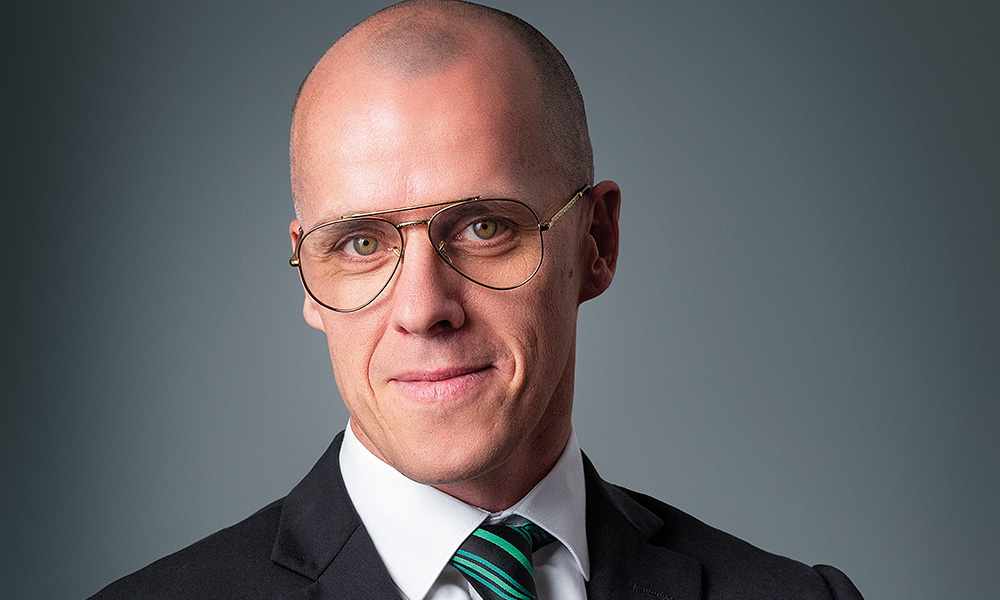Building a digital future
Khazna Data Centres’ Bart Holsters talks about the UAE’s data centre market, Khazna’s current operations and plans for the future, and sustainably operating data centres

According to data from Mordor Intelligence, the UAE data centre market size is estimated at 429.3MW in 2024, and is forecasted to grow by a CAGR of 14.39%, reaching 841MW by 2029. A report from the market intelligence firm notes that the high penetration and adoption of smartphones and 5G connectivity, and growing focus on digitisation are amongst the key drivers for the country’s growing data centre space.
The data centre market in the UAE has several players, however Khazna Data Center (Khazna) was said to have the lion’s share of the market, with a 45.8% share in 2023. Here, Big Project Middle East’s Jason Saundalkar talks to Bart Holsters, Senior Director – Operational Excellence at Khazna Data Centres about the UAE’s data centre market, Khazna’s current operations and plans for the future, and the challenges of sustainably operating these resource hungry facilities in the Middle East.
- Share an overview of the data centre market in the UAE focusing on trends and drivers. What trend is most responsible for stimulating the demand for data centres in the UAE?
Rapid urbanisation and data privacy regulations, fuelled further by population growth, is driving increased demand for data centre infrastructure to support the digital transformation of cities. We are also seeing a growing demand for advanced technologies, including artificial intelligence (AI). AI adoption requires robust computing resources and storage capacity, leading to higher demand for data centres. The proliferation of cloud infrastructure to support AI workloads and smart city initiatives further contributes to the growth of the data centre market, as organisations seek scalable and efficient computing resources for data processing and analysis.
Smart city projects, aimed at enhancing urban efficiency and sustainability through interconnected technologies, rely heavily on data centres to collect, store, and analyse data from various devices deployed across the city. With the increasing trends of rapid urbanisation, AI adoption, cloud infrastructure expansion, and smart city initiatives, there are significant opportunities for growth in the market. Furthermore, the UAE has invested heavily in high-speed internet connectivity and advanced networking technologies, providing the necessary backbone for data transmission and connectivity. Also, the availability of renewable power and the UAE’s clear commitment to a clean energy mix are key drivers for sustainable data centre growth.
Finally, and likely one of the most significant drivers stimulating the demand for data centres in the UAE is the government-led digital transformation initiatives to create a broader ecosystem that relies on robust IT infrastructure, including data centres, to support digital innovation and economic growth.
- How do you see data centre growth developing in the UAE going forward? What do you expect the market to look like by 2030?
The UAE’s data centre market is poised for significant growth due to a continued influx of investment from both the government and the private sector. This continued investment is driven by increasing demand for cloud and AI services, as well as the country’s digital transformation objectives to position itself as a regional digital hub. Further, the majority of data is nowadays produced by machines and sensors rather than by people alone, set to reach a staggering 175-zetabytes by 2025, according to some studies. We love data and we generate tons of it because we value the strategic advantages this “new gold” is likely to unlock.
Naturally, this new gold requires infrastructure to be hosted, processed and enabled to traverse the globe in a secure manner. This is why data centres or ‘Dataports’ have become indispensable pillars for socio-economic development, akin to the significance of airports and seaports. As the UAE keeps progressing towards becoming a smart nation, this expansion will also continue to drive the demand for data centre services to support the storage, processing, and analysis of large volumes of data generated these devices.
Furthermore, businesses are continuing to adopt multi-cloud strategies and are starting to leverage on the rapid developing AI technology. By 2030, the market is expected to see a further shift towards cloud and AI-focused data centres to facilitate a seamless integration between these different cloud environments and integrate the rapidly developing AI technology, and all with a strong emphasis on sustainability.
Khazna’s expansion efforts, coupled with our focus on eco-friendly practices, fully support the robust and innovative data centre ecosystems emerging in the coming years. To achieve this, Khazna is equally integrating and leveraging on the advances of these technologies, adopting AI-driven automation and predictive analytics to shape the future of our data centre operations, while optimising resource allocation, improving efficiency, and enhancing our service delivery.

- What is the profile of customers that Khazna works with to develop data centres for in the UAE?
Khazna Data Centers serves a diverse range of customers across various sectors, including telecommunications, financial services, healthcare, government, and AI. We provide solutions and services tailored to meet the specific needs of businesses, enabling them to securely store and manage their data.
- How many data centres does Khazna currently operate in the UAE? Please share stats and figures in terms of capacity, energy requirements etc.
Khazna currently has 23 data centres commissioned and an additional seven in delivery. We have a customer contracted capacity of 301MW and were the first carrier neutral pure wholesale data centre platform in the region. Environmental sustainability is a key consideration for Khazna. Our Future First strategy emphasises energy-efficient design, renewable energy sources, and carbon-neutral operations to reduce environmental impact. We are integrating sustainable technologies such as economisers, adiabatic cooling, renewable energy and biofuel conversion programme for our generators to name just a few, all contributing to Khazna achieving the region’s lowest annualized PUE at 1.4.
- What are the solutions and services that Khazna offers to its customers? What makes your firm stand out compared to other firms operating in the UAE?
For over a decade, Khazna has been a cornerstone of digital infrastructure development, propelling the UAE into an international technology hub and spearheading the advancement of the digital economy. Amidst this evolution, Khazna remains committed to adopting world-in-class integration of cutting-edge technologies into its wholesale service offerings.
What really sets Khazna apart is its continued drive to deliver superior customer experience, including a secure and reliable data center platform, meticulously designed to meet stringent industry green standards, connecting businesses to the future power of data for strategic growth and innovation. Our state-of-the-art facilities, combined with our expert team and strategic locations, create a digital ecosystem conducive to the seamless integration of Cloud and AI technologies, enabling our partners to unlock new possibilities and drive business success.
- What are some of the key factors for the design and development of data centre facilities in the UAE? How does data centre design, construction and operation in the UAE differ compared to Western markets?
Khazna facilities prioritise the adoption of cutting-edge technologies and sustainable practices. We aim to exceed international standards by focusing on eco-friendly solutions, while driving down costs for our clients. We emphasise best practices across our buildings, services, and staff, guided by industry accreditations. We strive for Uptime Institute’s Tier III certification for Constructed Facility, ensuring compliance with global standards and efficient construction methods. Additionally, Khazna holds LEED Gold and Estidama Pearl-4 certificates for construction, underscoring its commitment to sustainability. The data centres are also certified with ISO 27001:2013 accreditation, guaranteeing robust information security management systems implementation.
Compared to Western markets, the UAE’s hot and arid climate necessitates specialised cooling systems and infrastructure to manage high temperatures efficiently. Khazna’s facilities are built with these challenges in mind using external architectural elements crafted to protect the building from the adverse effects of direct sunlight. This design approach effectively reduces the infiltration of heat into the building, therefore enhancing the data centre’s efficiency and sustainability. In addition, Khazna’s facilities have adopted higher delta temperatures and use air cooled chiller systems with an option to trigger ‘free cooling’ and ‘adiabatic cooling’ when outdoor temperatures drop in winter, reducing the Power Usage Effectiveness (PUE) to a target of 1.4 reducing power bills.
- What are some of the learnings Khazna’s experts have accumulated in their journey from building/operating the company’s first data centre to the present?
Overall, Khazna’s journey of building and operating data centres has been marked by continuous innovation. Scalability and modularity of our designs have evolved along with the technology and market dynamics. Data centres need to accommodate increasing demands for power density and connectivity. Our modular designs and flexible architectures allow for adopting the latest technologies, easy expansion and upgrades without disrupting the operations. Another point of focus and constant learning is energy efficiency and minimising carbon footprint. This in addition of implementing stringent waste management policies throughout the lifecycle of the facility. Adopting Customer-Centric Approach since day one and spending time understanding the needs and expectations of our customers has also been crucial in developing personalised solutions, and transparent communication platforms to bolster trust and foster long-term partnerships.
Furthermore, many digital voyages are setting sail today, and data has become the lifeblood of innovation fuelling the need for more and larger digital infrastructure. With such expansive capacities reaching gigawatts sizes, an even greater responsibility rests on our shoulders to keep reinventing our designs in the realm of sustainability. To that end, we believe the industry has started a paradigm shift as it migrates into the power and cooling business. The data centres of tomorrow will be embracing a new identity as a vital ‘prosumer’, moving away from the mere consumer model, and becoming a conscientious contributor to the well-being of the communities it serves.
- What are some of the key challenges Khazna has faced in the design, construction and operation of data centres in the UAE? How were these challenges tackled?
As you can imagine there are a number of challenges that will naturally emerge when you are pioneering and are defining the benchmark for the region’s digital industry spanning the stages of design, construction, and operation.

In the design phase, accommodating the rapid growth of data centre demand while ensuring flexibility for future expansions posed a significant challenge. In our industry it is all about ‘time-to-market’. To address this, we have finetuned and adopted a standard innovative and modular design. Furthermore, we have adopted a modular design that involves assembling pre-fabricated components or modules off-site and then integrating them on-site. This approach enables a much faster deployment and also adds to easily adapt to market dynamics. Next to reducing construction time and costs, it also ensures a better grip on quality control and consistency throughout the constructed facilities. In addition, we are running zero waste programs, with an increased focus to minimising environmental impact and maximising energy efficiency, starting from construction and running through the operations of our facilities.
When it comes to operations, one of the most significant challenge is without a doubt the extreme climate conditions, necessitating a very efficient cooling infrastructure and a team of performance engineers to constantly monitor and optimise the cooling infrastructure. Furthermore, there is a significant shortage of skilled data centre professionals. Khazna has rolled out several programs to attract young graduates into the industry to address the talent shortage, as well as upskilling existing staff through development programs and courses.
- Real world and virtual security is critical to the smooth and reliable operation of data centres. How does Khazna tackle these issues?
Khazna addresses real-world and virtual security concerns through a multi-layered approach across its data centre facilities. Physical security measures include state-of-the-art surveillance systems, multiple ID verification methods to ensure every individual is accounted for, and 24/7 monitored security operations centre to safeguard against unauthorised access and physical threats.
We also employ advanced cybersecurity protocols and technologies to protect against virtual threats, ensuring the integrity, confidentiality, and availability of data stored within its facilities. These measures collectively contribute to the smooth and reliable operation of Khazna’s data centers, providing customers with peace of mind regarding the security of their critical infrastructure.
- Data centres are massive consumers of energy and have significant cooling requirements; how can these requirements be tackled sustainably as the world steps up its focus on achieving Net Zero?
As the world intensifies its focus on achieving Net Zero, addressing the significant energy consumption and cooling requirements of data centres is imperative. At Khazna Data Centers, we are spearheading sustainable initiatives to mitigate our carbon footprint. This includes transitioning to renewable energy sources like solar and wind power, reducing reliance on conventional energy and lowering greenhouse gas emissions.
Khazna also adopts innovative cooling methods such as adiabatic-free cooling chillers to optimise energy usage and minimise power consumption. Our modular approach enhances energy efficiency, scalability, and uptime, while our partnerships with entities like Emerge and BEEAH Digital further underscore our commitment to sustainability in the data centre industry.
The recent launch of Khazna’s flagship AUH6 data centre facility is a prime example of these sustainable initiatives. Located strategically in Masdar City, an urban development renowned for its commitment to sustainable practices and innovative technologies, AUH6 aligns with Khazna’s Future First Strategy. Through Khazna’s collaboration with Emerge, a ground-mounted solar photovoltaic (PV) plant has been developed to efficiently provide electricity to fuel the operations at AUH6. This solar plant boasts an impressive installed capacity of seven megawatts peak (MWp). The external architecture of the AUH6 was also crafted to protect the facility from the adverse effects of direct sunlight. This design approach effectively reduces the infiltration of heat into the building, therefore enhancing the data centre’s efficiency and sustainability.
Next to designing and building such state-of-the-art facilities, we also set ourselves some stringent KPI’s towards utilities consumption avoidance. There is no point in designing the best data centres in the region and then failing to operate them to the best of their abilities. Our operations team keeps on raising the bar relentlessly to optimise environmental metrics such as Carbon Usage Effectiveness (CUE), WUE (Water Usage Effectiveness) and generated waste.
Next to maintaining world class O&M standards, we also invest in the latest software stacks, embedding technology such as Machine Learning (ML) & AI to improve our analytics and decision-making capabilities, and working our way towards a truly predictive O&M environment. We also don’t shy away from integrating new technologies and sustainability programs into our existing fleet. Switching our diesel generators to biofuel is a great example of such implemented sustainability program to decarbonise our fleet.

In our commitment to waste reduction, we aspire to achieve the esteemed Zero Waste Certification within the coming 24 months. This prestigious certification exemplifies our dedication to minimising waste, and equally underscores our proactive approach towards environmental sustainability. By setting this ambitious goal, we aim not only to meet but to exceed regional standards, showcasing our unwavering commitment to a zero-waste future.
- Post COP28, has there been new legislation or mandates that directly affect data centres? If so, please detail these requirements and how Khazna is responding to them.
Apart from COP28 and regulatory requirements, at Khazna we believe that the data centre industry is uniquely positioned to lead in carbon neutrality efforts. Data centres inherently consume vast amounts of energy, but innovative strategies such as renewable energy sourcing, energy-efficient technologies, clean fuels, and waste heat recovery can significantly mitigate their environmental impact.
In our pursuit of a renewable future, we are dedicated to intelligently decarbonising our fleet and enhancing our impact on the communities we serve. Intermittency and low energy density are global challenges that make relying solely on renewable energy challenging. This combined with the increasing power constraints requires some forward thinking on how data centres of the future should be energised.
One way of doing this is utilising the installed backup-up power more efficiently and turn these mini-power plants into prime microgrids. Thermal power generation is particularly effective in the waste heat recovery process. By incorporating Heat Recovery Steam Generators (HRSGs), you can easily convert waste exhaust heat into steam, subsequently utilised for Combined Cycle (CC) power generation or Combined Cooling, Heating & Power (CCHP) power and cooling generation, enhancing the end-to-end energy cycle efficiency by 50 to 60%. These microgrids can be multiple source, complemented by renewables, storage systems and the conventional grid. Such microgrid is typically controlled by an intelligent Energy Management System (EMS) to allows to combine or switch between sources, always ensuring the most efficient and reliable source is used at any given point of time.
From a sustainability standpoint this approach assists to minimise natural resource wastage, optimises infrastructure utilisation, and immediately reduces carbon emissions. Such a strategic shift not only ensures better use of our energy resources but also establishes a clear pathway to achieving zero carbon emissions within the next decade or so. The technology is certainly not new, it simply requires some forward thinking to re-invent the conventional setup and configuration… and this is typically what we like to do at Khazna, Future First!
- What are Khazna’s plans for expansion, which markets in the Middle East are of most interest?
Khazna is strategically expanding its operations in line with the Middle East’s booming digital economy, projected to reach $780bn by 2030. With the UAE and Saudi Arabia leading investments in digital transformation, Khazna has ambitious growth plans to become a global leading data centre provider.
As we embark on our expansion journey, we are experiencing significant growth, not only within the UAE, but also in neighboring markets including Egypt, along with ambitious plans for Saudi Arabia and Kuwait. Notably, Khazna’s flagship data centre AUH 6, which is AI ready, sets new standards for efficiency and performance, while our entry into Egypt through a strategic JV partnership with Benya Group marks Khazna’s first international expansion, reinforcing our commitment to regional growth.
Khazna is also focusing on strategically expanding its operations in emerging markets where robust data centre infrastructure is lacking, focusing on regions with potential socio-economic benefits. With the Middle East’s digital economy set to soar, Khazna aims to bridge infrastructure gaps by establishing new data centres supporting the region’s digital growth. This expansion not only supports economic growth but also enhances regional connectivity and technological advancement.























